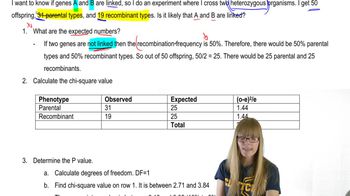Table of contents
- 1. Introduction to Genetics51m
- 2. Mendel's Laws of Inheritance3h 37m
- 3. Extensions to Mendelian Inheritance2h 41m
- 4. Genetic Mapping and Linkage2h 28m
- 5. Genetics of Bacteria and Viruses1h 21m
- 6. Chromosomal Variation1h 48m
- 7. DNA and Chromosome Structure56m
- 8. DNA Replication1h 10m
- 9. Mitosis and Meiosis1h 34m
- 10. Transcription1h 0m
- 11. Translation58m
- 12. Gene Regulation in Prokaryotes1h 19m
- 13. Gene Regulation in Eukaryotes44m
- 14. Genetic Control of Development44m
- 15. Genomes and Genomics1h 50m
- 16. Transposable Elements47m
- 17. Mutation, Repair, and Recombination1h 6m
- 18. Molecular Genetic Tools19m
- 19. Cancer Genetics29m
- 20. Quantitative Genetics1h 26m
- 21. Population Genetics50m
- 22. Evolutionary Genetics29m
4. Genetic Mapping and Linkage
Chi Square and Linkage
Problem 30a
Textbook Question
A Drosophila experiment examining potential genetic linkage of X-linked genes studies a recessive eye mutant (echinus), a recessive wing-vein mutation (crossveinless), and a recessive bristle mutation (scute). The wild-type phenotypes are dominant. Trihybrid wild-type females (all have the same genotype) are crossed to hemizygous males displaying the three recessive phenotypes. Among the 20,765 progeny produced from these crosses are the phenotypes and numbers listed in the table. Any phenotype not given is wild type. Phenotype Number 1. Echinus 8576 2. Scute 977 3. Crossveinless 716 4. Echinus, scute 681 5. Scute, crossveinless 8808 6. Scute, crossveinless, echinus 4 7. Echinus, crossveinless 1002 8. Wild type 1 20,765 Use chi-square analysis to demonstrate that the data in this experiment are not the result of independent assortment.
 Verified step by step guidance
Verified step by step guidance1
Identify the null hypothesis: The genes are assorting independently, meaning the observed phenotypic ratios should match the expected ratios based on Mendelian inheritance.
Calculate the expected number of progeny for each phenotype assuming independent assortment. This involves determining the expected frequency of each phenotype based on the probability of inheriting each trait independently.
Use the chi-square formula: \( \chi^2 = \sum \frac{(O_i - E_i)^2}{E_i} \), where \( O_i \) is the observed frequency and \( E_i \) is the expected frequency for each phenotype.
Determine the degrees of freedom for the chi-square test. This is calculated as the number of phenotypic categories minus the number of alleles being tested (in this case, 8 phenotypes - 3 alleles = 5 degrees of freedom).
Compare the calculated chi-square value to the critical value from the chi-square distribution table at the desired significance level (e.g., 0.05) to determine if the null hypothesis can be rejected, indicating linkage.
Recommended similar problem, with video answer:
 Verified Solution
Verified SolutionThis video solution was recommended by our tutors as helpful for the problem above
Video duration:
3mPlay a video:
Was this helpful?
Key Concepts
Here are the essential concepts you must grasp in order to answer the question correctly.
Genetic Linkage
Genetic linkage refers to the tendency of genes located close to each other on the same chromosome to be inherited together during meiosis. This phenomenon contrasts with independent assortment, where genes segregate independently. In the context of the Drosophila experiment, understanding genetic linkage is crucial for interpreting the observed ratios of phenotypes and determining whether the genes for eye color, wing veins, and bristles are linked.
Recommended video:
Guided course

Chi Square and Linkage
Chi-Square Analysis
Chi-square analysis is a statistical method used to determine if there is a significant difference between observed and expected frequencies in categorical data. In genetics, it helps assess whether the distribution of phenotypes in progeny deviates from what would be expected under the assumption of independent assortment. By applying this analysis to the Drosophila data, researchers can evaluate the hypothesis of linkage versus independent assortment.
Recommended video:
Guided course

Chi Square Analysis
Phenotypic Ratios
Phenotypic ratios represent the relative frequencies of different phenotypes observed in the offspring of a genetic cross. In this experiment, the ratios of the various Drosophila phenotypes provide insight into the inheritance patterns of the X-linked genes. Analyzing these ratios helps determine whether the observed frequencies align with Mendelian expectations, which is essential for concluding whether the genes assort independently or are linked.
Recommended video:
Guided course

Mutations and Phenotypes

 7:33m
7:33mWatch next
Master Chi Square and Linkage with a bite sized video explanation from Kylia Goodner
Start learningRelated Videos
Related Practice

